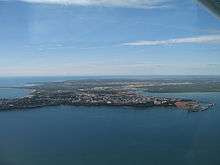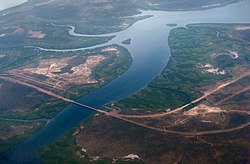Darwin Harbour
Darwin Harbour is the body of water close to Darwin in the Northern Territory of Australia. It opens to the north at a line from Charles Point in the west to Lee Point in the east into the Beagle Gulf and connects via the Clarence Strait with the Van Diemen Gulf.[1] It contains Port Darwin, which is flanked by Frances Bay to the east and Cullen Bay to the west.

Name
Darwin Harbour was named after the naturalist Charles Darwin who sailed with Robert Fitzroy on the ship HMS Beagle around parts of Australia. However, Darwin and Fitzroy sailed in 1836 from King George's Sound (Western Australia) directly to the Cocos-Keeling Islands, at the south coast of Java, and from there to Cape Town and back to England. They stayed thus away from Darwin Harbour by 3000 sea miles and did not know of its existence.[2]
Climate
The climate of the Darwin Harbour region is monsoon tropical with two distinct seasons: the Dry and the Wet. The Dry lasts for 6 months between April and September with an average rainfall of 24 mm, whereas the Wet lasts between October and March with an average monthly rainfall of 254 mm/month (according to the Bureau of Meteorology, 1999). The majority of the rain falls between December and April. Runoff varies between 250–1000 mm. Riverine discharge is relatively low with the exception of the Blackmore River and Elizabeth River. Peak flow for these rivers occurs in February, respectively 605Ml/day and 389 Ml/day, after which it slowly decreases until July when there is no freshwater input into Darwin Harbour until the onset of the following wet season (Padovan 1997). Cyclone frequency is low to moderate.[1]
Marine life
Darwin Harbour supports very high fish diversity with 415 fish species now known. Darwin Harbour provides a unique opportunity to see dugongs in the wild, because their favourite food is located off Casuarina and Vestey’s beaches. Seagrass meadows are also the main diet of green turtles and provide habitats for many smaller marine animals including commercially important species such as prawns and fish.[3]
Oceanography
Currents
The tides at Port Darwin are macro-tidal with a maximum tidal range of 7.8 m, a mean spring range of 5.5 m and a mean neap range of 1.9 m (Padovan, 1997). The currents caused by these tides are complex and strong.[1]
Estuaries

Darwin Harbour is a drowned river valley and consist of ria shorelines and extensive headlands.[1]
Catchment
The catchment of Darwin Harbour occupies a total area of approximately 3,230 square kilometres (1,247 sq mi), of this 2,010 square kilometres (776 sq mi) is land based and the other 1,220 square kilometres (471 sq mi) are estuarine areas at the high water mark.[4]
Geology
The underlying lithology is dominated by Permian siltstones and sandstones.[1]
Administrative status
On 4 April 2007, the remainder of Darwin Harbour which was not already part of a suburb or a locality within the boundaries of either of the two local government areas, the City of Darwin and the Litchfield Municipality, was gazetted by the Northern Territory Government as a locality with the name, Darwin Harbour. Its north-western boundary aligns with that of the boundary for the Port of Darwin which extends from Charles Point in the west to Lee Point in the east.[5][6] The locality has not been added to any existing local government area and is considered to be part of the Northern Territory's unincorporated areas.[7]
References
- N Smit, R Billyard and L Ferns: Beagle Gulf Benthic Survey: Characterisation of soft substrates. Archived March 28, 2012, at the Wayback Machine Technical Report No. 66 (2000), Parks and Wildlife Commission of the Northern Territory.
- Alan Powell:Who Named Beagle Gulf?: A Cautionary Tale. Journal of Northern Territory History, No. 22, 2011: 104-108. ISSN 1034-7488. Cited on 29 Oct 2012.
- Darwin Harbour’s Marine Life. Darwin Harbour Advisory Committee Update, December 2011, page 3.
- J. Drewry; J. Fortune; D. Browne (2010). "Water quality of the Elizabeth River estuary, Darwin Harbour, before and during the 2006-2007 wet season" (PDF). Aquatic Health Unit - Department of Natural Resources, Environment, The Arts and Sport. Archived from the original (PDF) on 28 March 2015. Retrieved 26 May 2015.
- "Place Names Register Extract - "Darwin Harbour"". NT Place Names Register. Northern Territory Government. Retrieved 25 February 2019.
- "Extent of the locality of 'Darwin Harbour'". NT Atlas and Spatial Data Directory. Northern Territory Government. Retrieved 25 February 2019.
- "Un-incorporated area - East Arm". Place Names Committee. Northern Territory Government. 2017. Retrieved 25 February 2019.
External links
![]()